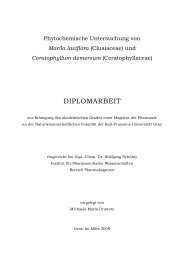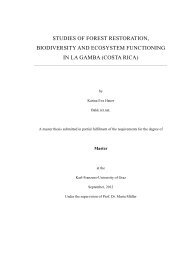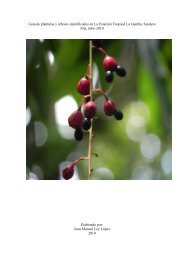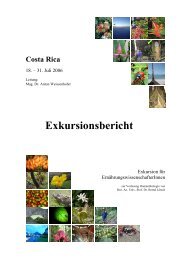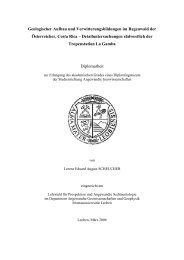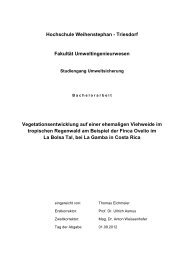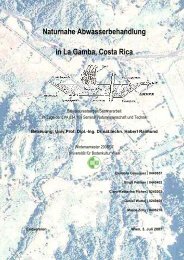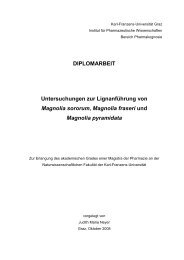Leaf colour patterns, vegetative and sexual reproduction of Episcia ...
Leaf colour patterns, vegetative and sexual reproduction of Episcia ...
Leaf colour patterns, vegetative and sexual reproduction of Episcia ...
You also want an ePaper? Increase the reach of your titles
YUMPU automatically turns print PDFs into web optimized ePapers that Google loves.
describes the fruit <strong>of</strong> <strong>Episcia</strong> as more or less a capsule, which dehisces loculicidally. The convex<br />
valves form a cup, which holds seeds with prominent funculi.<br />
Supposedly, the seeds are either dispersed by wind or rain or they just drop to the ground.<br />
Figure 28 <strong>Episcia</strong> lilacina; left: fruit after 25 days development; right: cross-section <strong>of</strong> one fruit with reddish<br />
seeds.<br />
Fruit Set<br />
The result <strong>of</strong> a successful pollination is the development <strong>of</strong> fruits <strong>and</strong> seeds. The amount <strong>of</strong><br />
the developed fruits gives information about the “<strong>reproduction</strong> effectiveness”. The fruit set was<br />
calculated by the number <strong>of</strong> developed fruits per 100 flowers.<br />
Materials <strong>and</strong> Methods: In total, 141 flowers were under observation. Two days after the<br />
end <strong>of</strong> anthesis it could be clearly determined if a successful pollination had taken place <strong>and</strong> if<br />
thus fruit development had begun. In case <strong>of</strong> a failed pollination the rest <strong>of</strong> the flower, which<br />
initially remained after the dropping <strong>of</strong> the corolla, decayed in the course <strong>of</strong> a few days. A<br />
premature dropping <strong>of</strong> fruits was not observed. However, the observation <strong>of</strong> the fruit<br />
development to ripeness could not be completed, because the stay in Costa Rica was too short.<br />
Fruit set was calculated by the following formula:<br />
fruit set =<br />
developed fruits<br />
100 flowers<br />
Results: 27 fruits developed from 141 flowers. That is 19 fruits per 100 flowers, i.e. the fruit<br />
set is 19%.<br />
62



